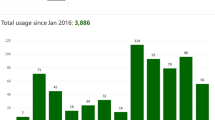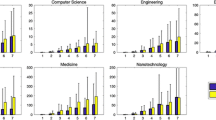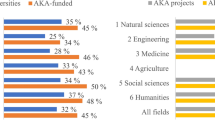Abstract
Research funding has been seen as one of the most important resource in the reward system of science. And usage of publications denotes an interesting perspective of user behavior in scientific communication. This study aims to address the relationship between funding and Usage Count, which is a new metrics item established on the platform of Web of Science. Full records of 300,010 articles published in 2013 were downloaded in October 2015, and divided into six disciplines, including information science library science, education educational research, economics, computer science, materials science, and chemistry. Seven indicators were proposed to measure the impact, including Funding rate, Citation per paper, Usage rate, Usage per paper, Citation difference, Usage difference, and Conversion rate. It concluded funding has impact on usage and citation, and funded papers attract more usage, but varying in different disciplines. Usage Count can be used in the extension of citation metrics but with limits. This study originally engages with usage metrics and detected that there is positive correlation between usage and funding.



Similar content being viewed by others
References
Ahlgren, P., Colliander, C., & Persson, O. (2012). Field normalized citation rates, field normalized journal impact and Norwegian weights for allocation of university research funds. Scientometrics, 92(3), 767–780.
Archambault, Éric, VignolaGagné, Étienne, Côté, G., Larivière, V., & Gingrasb, Y. (2006). Benchmarking scientific output in the social sciences and humanities: The limits of existing databases. Scientometrics, 68(3), 329–342.
Beaudry, C., & Allaoui, S. (2012). Impact of public and private research funding on scientific production: The case of nanotechnology. Research Policy, 41(9), 1589–1606.
Blume-Kohout, M., & Adhikari, D. (2016). Training the scientific workforce: Does funding mechanism matter? Research Policy, 45(6), 1291–1303.
Borgman, C. L., & Furner, J. (2002). Scholarly communication and bibliometrics. Annual Review of Information Science and Technology, 36(1), 3–72.
Boyack, K., & Borner, K. (2013). Indicator-assisted evaluation and funding of research: Visualizing the influence of grants on the number and citation counts of research papers. Journal of the American Society for Information Science and Technology, 54(5), 447–461.
Breschi, S., & Malerba, F. (2011). Assessing the scientific and technological output of EU Framework Programmes: Evidence from the FP6 projects in the ICT field. Scientometrics, 88(1), 239–257.
Conen, D., Torres, J., & Ridker, P. (2008). Differential citation rates of major cardiovascular clinical trials according to source of funding—a survey from 2000 to 2005. Circulation, 118(13), 1321–1327.
Costas, R., & van Leeuwen, T. (2012). Approaching the “reward triangle”: General analysis of the presence of funding acknowledgments and “peer interactive communication” in scientific publications. Journal of the American Society for Information Science and Technology, 63(8), 1647–1661.
Ebadi, A., & Schiffauerova, A. (2016). How to boost scientific production? A statistical analysis of research funding and other influencing factors. Scientometrics, 106(3), 1093–1116.
Fagan, J. (2014). The suitability of web analytics key performance indicators in the academic library environment. Journal of Academic Librarianship, 40(1), 25–34.
Folbe, A., et al. (2014). Scientific inquiry into rhinosinusitis: Who is receiving funding from the National Institutes of Health? Laryngoscope, 124(6), 1301–1307.
Fortin, J., & Currie, D. (2013). Big science vs. little science: How scientific impact scales with funding. PLoS ONE, 8(6), e65263.
Fournie, J. & Weihberg, R. (2013). The Funding Program “Open Access Publishing” of the German Research Community. On the Structure of Publication Funding at scientific Universities in Germany. Zeitschrift Fur Bibliothekswesen Und Bibliographie, 60(5), 236–243.
Furman, J., Murray, F., & Stern, S. (2012). Growing stem cells: The impact of federal funding policy on the US scientific frontier. Journal of Policy Analysis and Management, 31(3), 661-U151.
Gok, A., Rigby, J., & Shapira, P. (2016). The impact of research funding on scientific outputs: Evidence from six smaller European countries. Journal of the Association for Information Science and Technology, 67(3), 715–730.
Gorraiz, J., Gumpenberger, C., & Schlogl, C. (2014). Usage versus citation behaviours in four subject areas. Scientometrics, 101(2), 1077–1095.
Hargens, L., & Bott, D. (1991). Science, citation, and funding. Science, 251, 1409.
Helene, A., & Ribeiro, P. (2013). Brazilian scientific funding agency budgets have not matched the country’s economic growth. Brazilian Journal of Medical and Biological Research, 46(2), 117–120.
Hoekman, J., Scherngell, T., Frenken, K., & Tijssen, R. (2013). Acquisition of European research funds and its effect on international scientific collaboration. Journal of Economic Geography, 13(1), 23–51.
Hornbostel, S., et al. (2009). Funding of young scientist and scientific excellence. Scientometrics, 79(1), 171–190.
Huang, Y., et al. (2016). How does national scientific funding Support emerging interdisciplinary research: A comparison study of big data research in the US and China. PLoS ONE, 11(5), e0154509.
Jacob, B., & Lefgren, L. (2011). The impact of research grant funding on scientific productivity. Journal of Public Economics, 95(9–10), 1168–1177.
Jones, R., Younie, S., Macallister, A., & Thornton, J. (2010). A comparison of the scientific quality of publicly and privately funded randomized controlled drug trials. Journal of Evaluation in Clinical Practice, 16(6), 1322–1325.
Jowkar, A., Didegah, F., & Gazni, A. (2011). The effect of funding on academic research impact: A case study of Iranian publications. Aslib Proceedings, 63(6), 593–602.
Lariviere, V., Macaluso, B., Archambault, E., & Gingras, Y. (2010). Which scientific elites? On the concentration of research funds, publications and citations. Research Evaluation, 19(1), 45–53.
Lariviere, V., et al. (2011). Sex differences in research funding, productivity and impact: An analysis of Quebec university professors. Scientometrics, 87(3), 483–498.
Matthiessen, P. (2013). Complementary medicine and scientific pluralism—from governmental research funding to the dialogue forum of pluralism in medicine. Forschende Komplementarmedizin, 20(1), 43–57.
Okike, K., Kocher, M., Mehlman, C., & Bhandari, M. (2007). Conflict of interest in orthopedic research—an association between findings and funding in scientific presentations. Journal of Bone and Joint Surgery-American, 89A(3), 608–613.
Paul-Hus, A., Desrochers, N., & Costas, R. (2016). Characterization, description, and considerations for the use of funding acknowledgement data in Web of Science. Scientometrics, 108(1), 167–182.
Peritz, B. (1990). The citation impact of funded and unfunded research in economics. Scientometrics, 19, 199–206.
Pruthi, S., et al. (1997). Scientific community and peer review system—a case study of a central government funding scheme in India. Journal of Scientific & Industrial Research, 56(7), 398–407.
Reuters T. (2015). Web of science release note. http://wokinfo.com/media/pdf/wos_release_519.pdf Accessed 11 December 2017.
Rowe, S., et al. (2009). Funding food science and nutrition research: Financial conflicts and scientific integrity. Journal of Nutrition, 139(6), 1051–1053.
Schloegl, C., & Gorraiz, J. (2011). Global usage versus global citation metrics: The case of pharmacology journals. Journal of the American Society for Information Science and Technology, 62(1), 161–170.
Tahmooresnejad, L., Beaudry, C., & Schiffauerova, A. (2015). The role of public funding in nanotechnology scientific production: Where Canada stands in comparison to the United States. Scientometrics, 102(1), 753–787.
Tang, L., Hu, G., & Liu, W. (2017). Funding acknowledgment analysis: Queries and caveats. Journal of the Association for Information Science and Technology, 68(3), 790–794.
Venable, G. T., Khan, N. R., Taylor, D. R., Thompson, C. J., Michael, L. M., & Klimo, P. (2014). A correlation between national institutes of health funding and bibliometrics in neurosurgery. World Neurosurgery, 81(3–4), 468–472. https://doi.org/10.1016/j.wneu.2013.11.013.
Wang, X., Fang, Z., & Sun, X. (2016). Usage patterns of scholarly articles on Web of science: A study on Web of science usage count. Scientometrics, 109(2), 917–926.
Wang, X., Mao, W., Xu, S., & Zhang, C. (2014). Usage history of scientific literature: Nature metrics and metrics of Nature publications. Scientometrics, 98(3), 1923–1933.
Wang, J., & Shapira, P. (2011). Funding acknowledgement analysis: An enhanced tool to investigate research sponsorship impacts: The case of nanotechnology. Scientometrics, 87(3), 563–586.
Wu, J., Jin, M., & Ding, X. (2015). Diversity of individual research disciplines in scientific funding. Scientometrics, 103(2), 669–686.
Xu, X., Tan, A. M., & Zhao, S. X. (2015). Funding ratios in social science: The perspective of countries/territories level and comparison with natural sciences. Scientometrics, 104(3), 673–684.
Yan, E., Wu, C., & Song, M. (2017). The funding factor: A cross-disciplinary examination of the association between research funding and citation impact. Scientometrics. https://doi.org/10.1007/s11192-017-2583-8.
Zhao, X., Gao, X., & He, P. (2009). The h-index of science funding: Comprehensive characterization of the quantity and impact of funded papers. Bulletin of National Natural Science Foundation of China, 23(1), 15–18. (in Chinese).
Zhao, S. X., Yu, S., Tan, A. M., et al. (2016). Global pattern of science funding in economics. Scientometrics, 109(1), 463–479.
Acknowledgements
Funding was provided by National Nature Science Foundation of China (Grant No. 71503083), Social Science Foundation of Shanghai (2015BTQ002), “Chenguang Program” supported by Shanghai Education Development Foundation and Shanghai Municipal Education Commission (Grant No. 17CG19) and China Postdoctoral Science Foundation (Grant No. 2017M620142).
Author information
Authors and Affiliations
Corresponding author
Rights and permissions
About this article
Cite this article
Zhao, S.X., Lou, W., Tan, A.M. et al. Do funded papers attract more usage?. Scientometrics 115, 153–168 (2018). https://doi.org/10.1007/s11192-018-2662-5
Received:
Published:
Issue Date:
DOI: https://doi.org/10.1007/s11192-018-2662-5




